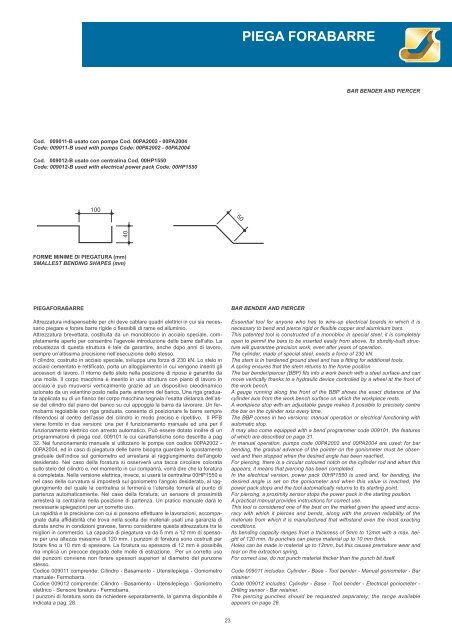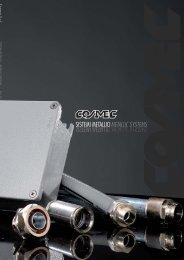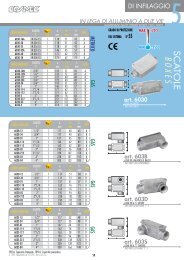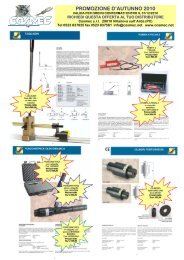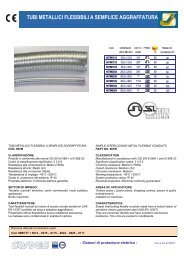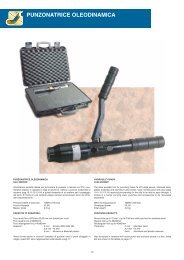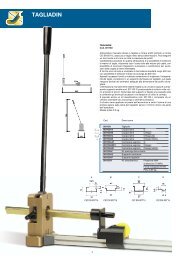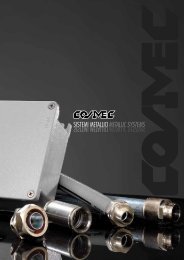piega forabarre
piega forabarre
piega forabarre
You also want an ePaper? Increase the reach of your titles
YUMPU automatically turns print PDFs into web optimized ePapers that Google loves.
PIEGA FORABARRE<br />
BAR BENDER AND PIERCER<br />
Cod. 009011-B usato con pompe Cod. 00PA2002 - 00PA2004<br />
Code: 009011-B used with pumps Code: 00PA2002 - 00PA2004<br />
Cod. 009012-B usato con centralina Cod. 00HP1550<br />
Code: 009012-B used with electrical power pack Code: 00HP1550<br />
100<br />
50<br />
40<br />
FORME MINIME DI PIEGATURA (mm)<br />
SMALLEST BENDING SHAPES (mm)<br />
PIEGAFORABARRE<br />
Attrezzatura indispensabile per chi deve cablare quadri elettrici in cui sia necessario<br />
<strong>piega</strong>re e forare barre rigide o flessibili di rame ed alluminio.<br />
Attrezzatura brevettata, costituita da un monoblocco in acciaio speciale, completamente<br />
aperto per consentire l’agevole introduzione delle barre dall’alto. La<br />
robustezza di questa struttura è tale da garantire, anche dopo anni di lavoro,<br />
sempre un’altissima precisione nell’esecuzione dello stesso.<br />
Il cilindro, costruito in acciaio speciale, sviluppa una forza di 230 kN. Lo stelo in<br />
acciaio cementato e rettificato, porta un alloggiamento in cui vengono inseriti gli<br />
accessori di lavoro. Il ritorno dello stelo nella posizione di riposo è garantito da<br />
una molla. Il corpo macchina è inserito in una struttura con piano di lavoro in<br />
acciaio e può muoversi verticalmente grazie ad un dispositivo oleodinamico<br />
azionato da un volantino posto nella parte anteriore del banco. Una riga graduata<br />
applicata su di un fianco del corpo macchina segnala l’esatta distanza dell’asse<br />
del cilindro dal piano del banco su cui appoggia la barra da lavorare. Un fermobarra<br />
regolabile con riga graduata, consente di posizionare le barre sempre<br />
riferendosi al centro dell’asse del cilindro in modo preciso e ripetitivo. Il PFB<br />
viene fornito in due versioni: una per il funzionamento manuale ed una per il<br />
funzionamento elettrico con arresto automatico. Può essere dotato inoltre di un<br />
programmatore di <strong>piega</strong> cod. 009101 le cui caratteristiche sono descritte a pag<br />
32. Nel funzionamento manuale si utilizzano le pompe con codice 00PA2002 -<br />
00PA2004, ed in caso di <strong>piega</strong>tura delle barre bisogna guardare lo spostamento<br />
graduale dell’indice sul goniometro ed arrestarsi al raggiungimento dell’angolo<br />
desiderato. Nel caso della foratura si osserverà una tacca circolare colorata<br />
sullo stelo del cilindro e, nel momento in cui comparirà, vorrà dire che la foratura<br />
è completata. Nella versione elettrica, invece, si userà la centralina 00HP1550 e<br />
nel caso della curvatura si imposterà sul goniometro l’angolo desiderato, al raggiungimento<br />
del quale la centralina si fermerà e l’utensile tornerà al punto di<br />
partenza automaticamente. Nel caso della foratura, un sensore di prossimità<br />
arresterà la centralina nella posizione di partenza. Un pratico manuale darà le<br />
necessarie s<strong>piega</strong>zioni per un corretto uso.<br />
La rapidità e la precisione con cui si possono effettuare le lavorazioni, accompagnate<br />
dalla affidabilità che trova nella scelta dei materiali usati una garanzia di<br />
durata anche in condizioni gravose, fanno considerare questa attrezzatura tra le<br />
migliori in commercio. La capacità di <strong>piega</strong>tura va da 5 mm a 12 mm di spessore<br />
per una altezza massima di 120 mm. i punzoni di foratura sono costruiti per<br />
forare fino a 10 mm di spessore. La foratura su spessore di 12 mm è possibile<br />
ma implica un precoce degrado delle molle di estrazione. Per un corretto uso<br />
dei punzoni conviene non forare spessori superiori al diametro del punzone<br />
stesso.<br />
Codice 009011 comprende: Cilindro - Basamento - Utensile<strong>piega</strong> - Goniometro<br />
manuale- Fermobarra.<br />
Codice 009012 comprende: Cilindro - Basamento - Utensile<strong>piega</strong> - Goniometro<br />
elettrico - Sensore foratura - Fermobarra.<br />
I punzoni di foratura sono da richiedere separatamente, la gamma disponibile è<br />
indicata a pag. 28.<br />
BAR BENDER AND PIERCER<br />
Essential tool for anyone who has to wire-up electrical boards in which it is<br />
necessary to bend and pierce rigid or flexible copper and aluminium bars.<br />
This patented tool is constructed of a monobloc in special steel, it is completely<br />
open to permit the bars to be inserted easily from above. Its sturdily-built structure<br />
will guarantee precision work, even after years of operation.<br />
The cylinder, made of special steel, exerts a force of 230 kN.<br />
The stem is in hardened ground steel and has a fitting for additional tools.<br />
A spring ensures that the stem returns to the home position.<br />
The bar bender/piercer (BBP) fits into a work bench with a steel surface and can<br />
move vertically thanks to a hydraulic device controlled by a wheel at the front of<br />
the work bench.<br />
A gauge running along the front of the BBP shows the exact distance of the<br />
cylinder axis from the work bench surface on which the workpiece rests.<br />
A workpiece stop with an adjustable gauge makes it possible to precisely centre<br />
the bar on the cylinder axis every time.<br />
The BBP comes in two versions: manual operation or electrical functioning with<br />
automatic stop.<br />
It may also come equipped with a bend programmer code 009101, the features<br />
of which are described on page 31.<br />
In manual operation, pumps code 00PA2002 and 00PA2004 are used; for bar<br />
bending, the gradual advance of the pointer on the goniometer must be observed<br />
and then stopped when the desired angle has been reached.<br />
For piercing, there is a circular coloured notch on the cylinder rod and when this<br />
appears, it means that piercing has been completed.<br />
In the electrical version, power pack 00HP1550 is used and, for bending, the<br />
desired angle is set on the goniometer and when this value is reached, the<br />
power pack stops and the tool automatically returns to its starting point.<br />
For piercing, a proximity sensor stops the power pack in the starting position.<br />
A practical manual provides instructions for correct use.<br />
This tool is considered one of the best on the market given the speed and accuracy<br />
with which it pierces and bends, along with the proven reliability of the<br />
materials from which it is manufactured that withstand even the most exacting<br />
conditions.<br />
Its bending capacity ranges from a thickness of 5mm to 12mm with a max. height<br />
of 120 mm. Its punches can pierce material up to 10 mm thick.<br />
Holes can be made in material up to 12mm, but this causes premature wear and<br />
tear on the extraction spring.<br />
For correct use, do not punch material thicker than the punch bit itself.<br />
Code 009011 includes: Cylinder - Base - Tool bender - Manual goniometer - Bar<br />
retainer<br />
Code 009012 includes: Cylinder - Base - Tool bender - Electrical goniometer -<br />
Drilling sensor - Bar retainer.<br />
The piercing punches should be requested separately; the range available<br />
appears on page 28.<br />
23


